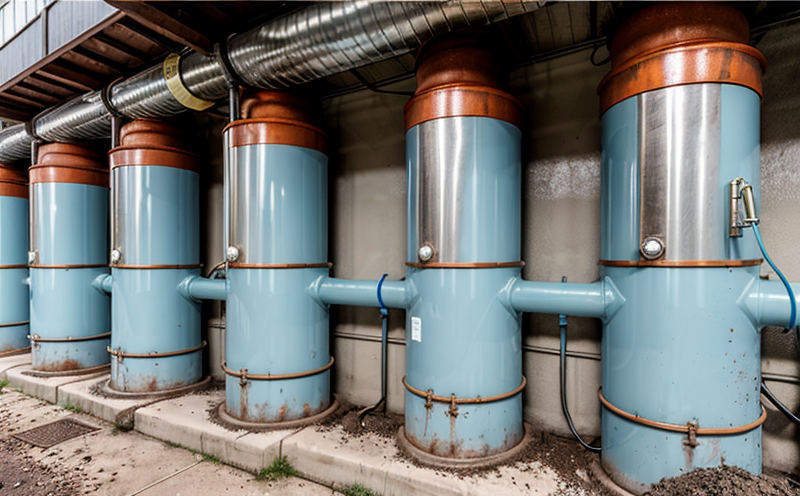ASTM G225 Corrosion Pit Density Test in Water Systems
The ASTM G225 standard provides a method for quantifying the density of corrosion pits present on metal surfaces within water systems. This testing is critical for ensuring the integrity and longevity of piping, storage tanks, and other metallic components used in water distribution networks.
Corrosion can significantly impact the performance and safety of water systems by leading to leaks, structural failures, and contamination risks. By measuring the density of corrosion pits, facilities can identify areas that are prone to accelerated deterioration and take preventive measures to mitigate potential issues.
The ASTM G225 test is particularly useful in environments where aggressive water chemistry may accelerate metal degradation. This includes systems serving areas with high levels of dissolved oxygen, chlorides, or other corrosive compounds. Understanding the extent of pit formation helps facilities prioritize maintenance efforts and implement targeted corrosion control strategies.
During testing, a representative sample of the metallic surface is prepared according to ASTM G225 guidelines. The surface must be clean, free of dirt, oil, and rust, to ensure accurate results. Once cleaned, the sample undergoes visual inspection using a 10x magnification loupe or microscope. This step allows technicians to identify areas with visible pitting.
The next stage involves etching the sample in a solution designed to enhance pit visibility without causing further corrosion. The etchant typically contains hydrofluoric acid (HF) and nitric acid (HNO₃), which selectively attack the metal around the pits, making them more pronounced for accurate counting.
After etching, the technician uses a calibrated pit gauge or digital microscope to count and measure the diameters of individual corrosion pits. The density is calculated by dividing the total number of pits per unit area by the surface area measured. This provides a quantitative assessment of the level of pitting present on the sample.
ASTM G225 specifies that the test should be conducted under controlled conditions to ensure reproducibility and reliability. These include consistent temperature, humidity, and lighting levels during etching and inspection. The use of standardized etchant solutions and calibrated equipment further enhances accuracy.
The results of the ASTM G225 test are valuable for several reasons. They provide a baseline for monitoring changes in pitting over time, allowing facilities to evaluate the effectiveness of corrosion control measures such as cathodic protection or the addition of protective coatings. Additionally, these data can inform decisions regarding the replacement or repair of corroded components.
By adhering to ASTM G225 standards, water and wastewater treatment plants can ensure that their systems meet regulatory requirements and industry best practices. This testing method is particularly important in sectors where potable water quality must be maintained at high standards, such as municipal water supply networks or industrial processes requiring clean water.
Facilities that regularly perform ASTM G225 tests should consider implementing a robust quality assurance program to maintain consistent test procedures and results. Regular training for technicians involved in the testing process is essential to ensure compliance with the standard's requirements.
Applied Standards
- ASTM G225-18a: Standard Practice for Measuring Corrosion Pit Density in Water Systems
- ISO 9243:1996: Metallic corrosion due to hydrogen embrittlement - Determination of the effect by immersion test
- EN 15078:2013: Corrosion protection of steel products for use in water and wastewater systems
The ASTM G225 standard is widely recognized in the industry as a reliable method for assessing corrosion pit density. It complements other standards such as ISO 9243, which focuses on hydrogen embrittlement testing, and EN 15078, which provides guidelines for corrosion protection of steel products used in water systems.
Industry Applications
The ASTM G225 test is applicable across various sectors where metallic components are exposed to aggressive water environments. Municipal utilities rely on this method to ensure the integrity of their water distribution networks, while industrial facilities use it to protect critical process equipment.
In municipal water systems, regular ASTM G225 testing helps identify areas requiring maintenance or replacement before they lead to catastrophic failures. This proactive approach not only enhances operational efficiency but also reduces downtime and associated costs.
For industrial applications, such as power plants or chemical processing facilities, the test ensures that critical equipment remains free from corrosion-induced degradation. By adhering to ASTM G225 standards, these industries can maintain compliance with regulatory requirements while safeguarding their infrastructure against costly repairs or replacements.
Quality and Reliability Assurance
- Consistent Temperature Control: Maintaining a controlled environment during etching and inspection to ensure accurate results.
- Calibrated Equipment: Using calibrated pit gauges or digital microscopes for precise measurements of pit dimensions.
- Standardized Etchant Solutions: Employing standardized etchant solutions to enhance visibility without causing further corrosion.
- Regular Calibration Checks: Conducting periodic calibration checks on all testing equipment to ensure accuracy over time.
- Training and Certification: Ensuring that technicians involved in the ASTM G225 test are trained and certified according to industry best practices.
A robust quality assurance program is essential for maintaining consistent results and ensuring compliance with ASTM G225 standards. Facilities should implement regular audits of testing procedures, including documentation of all tests performed, to identify any potential deviations from the standard.
By adhering to these best practices, facilities can enhance their reputation as leaders in water quality management while ensuring that their systems meet or exceed regulatory requirements.





